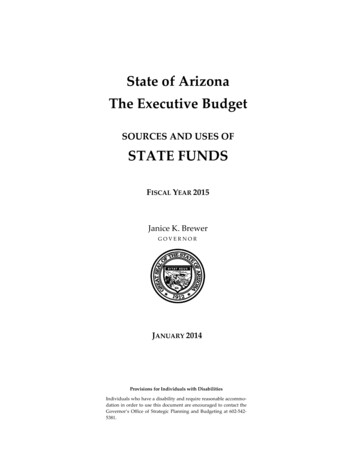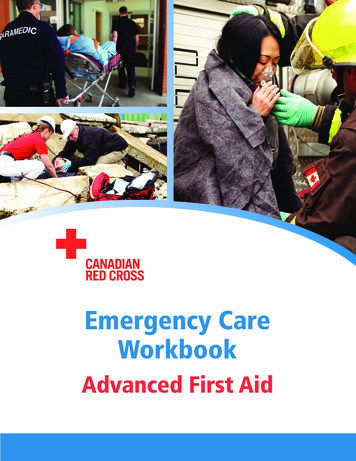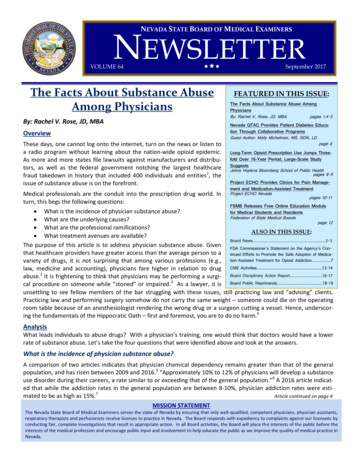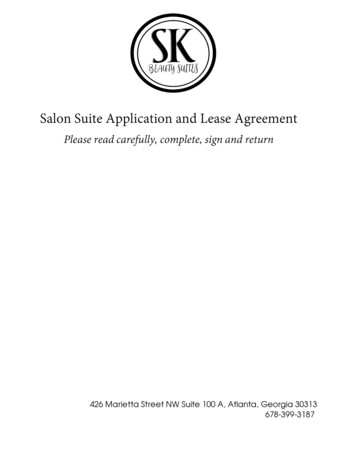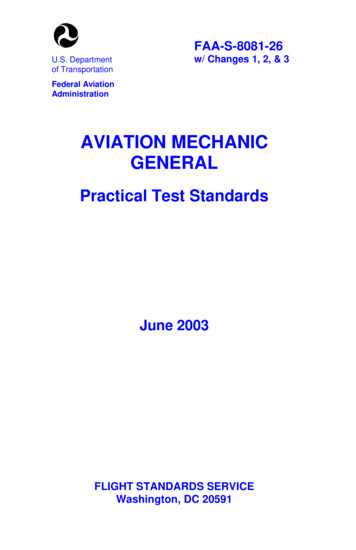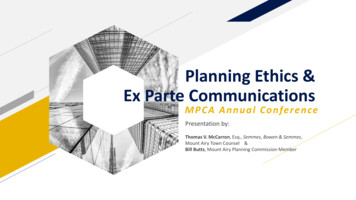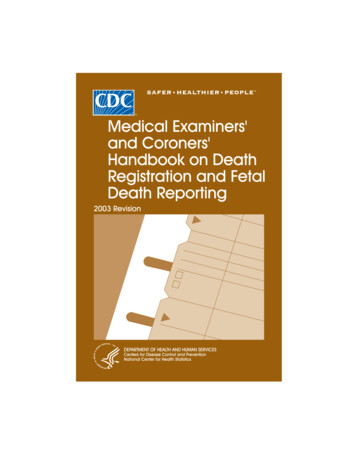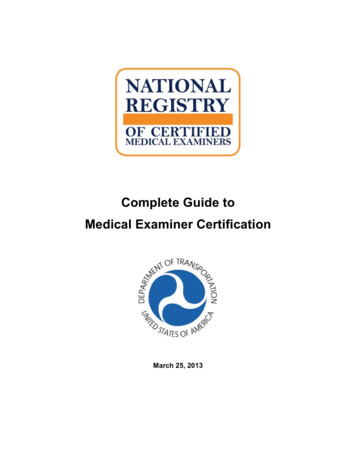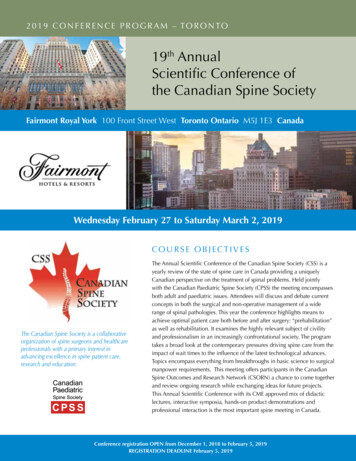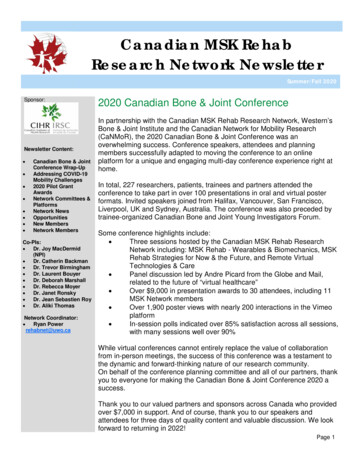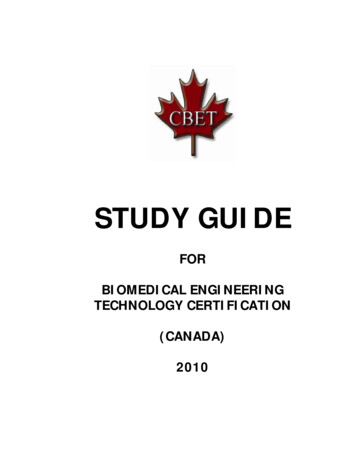
Transcription
STUDY GUIDEFORBIOMEDICAL ENGINEERINGTECHNOLOGY CERTIFICATION(CANADA)2010
BMET Certification Canada – Study Guide – revised January 2010PREFACEThis Study Guide has been prepared to provide an overview to those wishing to take theBiomedical Engineering Technology Certification examination set by the Canadian Board ofExaminers for Biomedical Engineering and Dialysis Technologists and Technicians.It provides information about the Certification program in Canada, a suggested reading listand a “mini-examination”, which reveals the style and type of questions one can expect in theactual examination. Correct answers are provided for self study. In the case of the essayquestions, a guide to the type of information that should be included in the answer isprovided.Every effort has been made to ensure accuracy throughout this guide, however, should errorsarise, the Canadian Board of Examiners for Biomedical Engineering and Dialysis Technologistsand Technicians will not be held responsible.NOTE: No part of this study guide may be reproduced by any means either electronically,facsimile, photocopied or transmitted without written consent from the Canadian Board ofExaminers for Biomedical Engineering and Dialysis Technologists and Technicians.EnquiriesYou may direct your enquiries to the cf.ca613-825-1837BMET Certification Canada87 Halley St.Nepean, ONK2J 3R5CanadaCopyright 2010 BMET Certification CanadaPage 2 of 31
BMET Certification Canada – Study Guide – revised January 2010Canadian Biomedical Engineering Technology Certification ProgramThank you for your interest in the Canadian Biomedical Engineering Technology CertificationProgram. Included in this Study Guide are the program information, application procedure,eligibility requirements, fees and exam format for either a Technologist or a Technician, andan application form.The procedure is as follows:1. Upon receipt of a completed application form and fee, you will receive a receipt foryour payment, which will indicate that your file has been activated.2. The Secretariat will send out reference requests to the people indicated on your form.3. Upon receipt of these completed references, your file is directed to the Board ofExaminers for review. The Board will determine if you meet the requirements forexamination, or if additional information, or further study is required.4. When the Secretariat has been advised of your acceptance for examination, a proctorwill be appointed to oversee the written examination. The proctor will be a qualifiedexaminer in your city/town, or as close as possible.5. You will be given 8 hours to complete the examination, the format of which is detailedlater in this Study Guide. The use of hand-held scientific calculator (no calculators thatallow text storage or formulation(s)) and one 7.6 cm by 12.7 cm card with formulas isallowed. The card shall only contain formulas (no text) on both sides and shall have afont size of not less than 8 pitch. No electronic communication devices will be allowedin the examination room.6. Upon successful completion of the written examination, the Board will advise you ofyour results. The Board then makes its recommendation to the InternationalCertification Commission, and a Certificate will be issued.7. If you have not achieved a passing mark on the written exam, you will be given atime period to study in your area(s) of weakness, and then you can rewrite anexamination that focuses on this area.8. Your Certificate is sent to the Canadian Board Chairman for signature and then youwill be consulted as to whether you wish it to be sent to your supervisor forpresentation or to have it presented at the Canadian Conference AwardsLuncheon/Banquet.The aim is to assist you to successfully complete this examination; therefore, you will be givenseveral opportunities to rewrite until the Board is satisfied that you meet the standardsrequired. We will also make every effort to provide examinations in a location that you mighteasily access.An annual renewal fee is implemented to maintain the Canadian Certification process andprovides your listing to the International Certification Commission Directory of CertifiedIndividuals.Copyright 2010 BMET Certification CanadaPage 3 of 31
BMET Certification Canada – Study Guide – revised January 2010CERTIFICATION OF BIOMEDICAL ENGINEERINGTECHNOLOGISTS/TECHNICIANSThe International Certification Commission (ICC) has a membership, which provides broadrepresentation of relevant members of the health care community. It includes representativesfrom engineering, medical, industrial, and government groups and agencies. It supervises thecertification of biomedical engineering technologist and technician, clinical engineers, andother related specialists through the organization of examining boards.As guided by the Commission, the Canadian Board of Examiners for Biomedical EngineeringTechnologists and Technicians (BMET Certification) considers that a biomedical engineeringtechnologist or technician is a person knowledgeable in the theory of operation, theunderlying physiologic principle, and the practical, safe, clinical application of biomedicalequipment. His/her capabilities may include installation, calibration, inspection, preventativemaintenance, and repair of general biomedical and related technical equipment, and inequipment control, safety and maintenance.CERTIFICATION EXAMINATION IN CANADAIn Canada, technologists and technicians, (as determined by the candidate’s provincialcertification) write the same multiple choice examination. However, the essays section isdifferent for each. Throughout this text the acronym BMET refers to both technologist andtechnician.The basic eligibility requirement for being examined for certification is registration with yourprovincial association as a certified engineering technologist or technician (see Eligibility, nextpage). The certification examination is designed to test your fundamental knowledge ofelectronics circuitry and biomedical capabilities.The content of the examination is based on the following premises:The BMET must be able to communicate intelligibly with physicians, and other hospital staffmembers. Also, in order to fulfill his responsibilities in the area of safety, calibration, andrelated areas, he/she must have a reasonable knowledge of anatomy and physiology. Theknowledge should include familiarity with terminology and body functions/systems.The BMET should possess a broad knowledge of equipment and laboratory instrumentationused in a clinical setting. His/her knowledge should include, but not be limited to, the theoryof operation, clinical application, and unique safety requirements relating to physiologicalmonitors, analytical laboratory instruments, vacuum and gas pressure vessels and controls,anaesthesia equipment, information systems interfaces, ventilators, imaging devices (includingMRI, CT, PET, X-Ray and ultrasound), physiological instruments, electrosurgical units, lasers(YAG, CO2, etc), renal dialysis, noninvasive surgical instruments. .etc.The BMET should be able to perform theoretical troubleshooting using schematics, forequipment ranging from the simple fibre optic light source to the microprocessor basedelectromyograph. The BME Technologist should also possess basic management andsupervisory skills.Copyright 2010 BMET Certification CanadaPage 4 of 31
BMET Certification Canada – Study Guide – revised January 2010ELIGIBILITY REQUIREMENTS1. A certified member, in good standing, of a provincial association of engineeringtechnicians and technologists, recognized by the Canadian Council of Technicians andTechnologists.2. The candidate shall have a minimum of 3 years experience in a clinical environment.ORCandidates, who are graduates of a recognized BMET post-secondary school program,will be allowed to count a maximum of 1-year internship period as part of the 3-yearrequirement.3. It is not necessary that the candidate be currently employed by a hospital, but it isrequired that the candidate have the above experience.4. The applicant shall submit the names of at least 5 references. These references mustbe health care professionals who are familiar with the candidate’s competence in thefollowing areas:a) Technical ability.b) Clinical experience interfacing with physicians.c) Clinical experience interfacing with nursing staff.d) And 2 others who have knowledge of the candidate’s work experience.Note: If a physician reference (b) is not available, include an additional nursingreference (c).The names of references are requested on the application form. Confidentialquestionnaires will be mailed to the referees by the Secretariat. These forms arereturned directly to the Secretariat.FEEThe application fee is subject to annual review, (see schedule). This fee is non-refundableafter you have been accepted for examination. The fee is to cover the cost of processing yourapplication and one examination session (if you are determined eligible to test forcertification). If after the receipt of references and review by the Board, it is decided that youare not eligible for examination; your fee will be refunded, less an administration fee to covercosts to that point.Copyright 2010 BMET Certification CanadaPage 5 of 31
BMET Certification Canada – Study Guide – revised January 2010APPLICATIONA BMET Certification Application form must be completed (included in this Study Guide).Curriculum Vitae are not acceptable in lieu of the completed form.Mail the completed application form to the Secretariat.The Secretariat will obtain the applicant’s references and send the application together withthe references to the Board of Examiners for review.REVIEW BY EXAMINERSThe Board of Examiners will decide whether or not the applicant is qualified to take theexamination. The applicant is then informed of his/her eligibility to take the examination.If the Board does not recommend testing, the applicant is informed and he/she may chooseto follow the appeal procedure. Information about the appeal procedure will be provided bythe Board’s Secretariat upon request.CERTIFICATIONExamination Format:The examination is divided into two parts. The first part is in multiple-choice format andincludes five (5) sections that cover the topics of Anatomy and Physiology, Basic Electronics,Medical Instrumentation, Troubleshooting, and Canadian Standards.The second part contains Essay questions pertaining to the practice and organizationalmanagement of Biomedical Engineering Programs.A minimum mark of 50% is required in each of the six (6) sections. 75% of the marks gainedin the first five (5) sections, plus 25% of the mark gained in the essay section, will constitutethe final mark attained. The final mark attained must equal or exceed 60%, with all sectionsreceiving a mark of 50% or more, for a pass to be granted.CERTIFICATION RENEWAL FEERenewal Fees are due in the first January following successful completion of the examinationand then in January of each year thereafter. The Certification Fee Schedule lists the amountsinvolved in the process.CERTIFICATION FEE SCHEDULEEXAMINATION FEEREFUND (not accepted for examination)SUPPLEMENTAL EXAM (per section)ANNUAL RENEWAL FEECopyright 2010 BMET Certification Canada 195.00 145.00 90.00 60.00Page 6 of 31
BMET Certification Canada – Study Guide – revised January 2010APPLICATION FORM FOR BMET CERTIFICATIONINSTRUCTIONSTo avoid delays in processing your application fill out the application form clearly, accuratelyand completely.Your eligibility for certification will be judged on: The information you provide on this application formThe opinions of your referencesThe results of your written examinationBe sure to: Sign the statement at the bottom of this pageInclude the examination fee (C 195) with your completed applicationmake cheques payable to : BMET CERTIFICATION CANADAMail the completed application form to:The SecretariatBMET Certification Canada87 Halley St.Nepean, ONK2J 3R5 CanadaCANDIDATE’S STATEMENTI,(PRINT NAME) , certify that all information that I have entered on thisapplication form, and any accompanying documents, is correct. I understand that anymisrepresentation may result in the rejection of this application, or the revocation of any certificateissued as a result of this application. I am also aware that any certification that I may receive from theCertification Commission will not constitute, and shall not be construed as, a license. I authorize, andrelease from all liability, the Certification Board of Examiners (Canadian) in doing so, to make anyenquiries that are necessary in ascertaining my eligibility for certification.Signature of ApplicantCopyright 2010 BMET Certification CanadaDatePage 7 of 31
BMET Certification Canada – Study Guide – revised January 2010PERSONAL INFORMATION (PLEASE PRINT)NAME:(As you wish it to appear on your certificate)Salutation:MissMs.Mrs.Dr.Mr.Check one only.HOME ADDRESS:StreetCityProvincePostal CodeHOME TELEPHONE: HOME E-MAIL:Area CodeNumberPRESENT EMPLOYER:WORK ADDRESS:StreetCityProvincePostal CodeDEPARTMENT: CURRENT POSITION:WORK TELEPHONE: WORK E-MAIL:Area CodeNumberNAME AND TITLE OF IMMEDIATE SUPERVISOR:SEND PERSONAL LETTER MAIL TO:HOMEWORKSEND PERSONAL ELECTRONIC MAIL (E-MAIL) TO:HOMEWORKNAME OF PROVINCIAL ASSOCIATION OF TECHNICIANS/TECHNOLOGISTS WITH WHICH YOUARE CERTIFIED:DATE OF JOINING THIS ASSOCIATION: MEMBERSHIP NUMBER:TITLE: CLASSIFICATION:TECHNICIAN OR TECHNOLOGIST?NAME OFSCHOOLC.E.T., A.Sc.T., ETC.LOCATIONOFFICE USE geOtherCopyright 2010 BMET Certification CanadaPage 8 of 31TODEGREE
BMET Certification Canada – Study Guide – revised January 2010BIOMEDICAL ENGINEERING EXPOSUREDuring any part of your formal education, were you exposed to working in a biomedicalenvironment (internship), which was included in the curriculum?YesNoIf “Yes”, please list dates, institution and a brief description of the work you performed:Have you attended any major biomedical conferences, seminars, or meetings sponsored by anaccredited organization?YesNoIf “yes”, please list:DateEventSponsorList your major disciplinary interests in the field of biomedical technology (e.g. Haematology,Respiration, Cardiology, etc.)Upon successful completion of the Certification Examination process you may opt for yourname to be listed on the ICC Web site as a Canadian Certified Biomedical EngineeringTechnician/Technologist.YesNoI wish my name to be listed on the ICC Web siteNote that the default of “Yes” will be applied if you fail to complete this section.Copyright 2010 BMET Certification CanadaPage 9 of 31
BMET Certification Canada – Study Guide – revised January 2010EMPLOYMENT rt with your most recent employment and account foreach year since High School. Include the name andlocation of your employers, titles of your positions anddescriptions of your duties. If more space is required adda separate sheet.OUTSTANDING ACHIEVEMENTSAttach a separate sheet to describe any outstanding achievements on your part that you feelthe Board of Examiners should evaluate when considering your application. This could includepublications, special projects, incident investigations, research projects, safety programmes,etc.Copyright 2010 BMET Certification CanadaPage 10 of 31
BMET Certification Canada – Study Guide – revised January 2010REFERENCESList the names and contact information (PLEASE PRINT) of five (5) health care deliveryprofessionals who may be consulted for the purpose of providing references in the followingareas:a. technical abilityb. clinical experience interfacing with physiciansc. clinical experience interfacing with nursing staffd. and two (2) others who have knowledge of your work experienceNote: If a physician reference (b) is not available, replace (b) with a secondnursing reference (c)Obtain permission to use the references that you provide and inform them thatthey will be requested to complete a questionnaire, which will be sent to them viae-mail (preferred) or surface mail.REF. 1 NAME & ncePostal CodeTELEPHONE: E-MAIL:AREA CODENUMBERREF. 2 NAME & ncePostal CodeTELEPHONE: E-MAIL:AREA CODENUMBERREF. 3 NAME & ncePostal CodeTELEPHONE: E-MAIL:AREA CODENUMBERREF. 4 NAME & ncePostal CodeTELEPHONE: E-MAIL:AREA CODENUMBERREF. 5 NAME & ncePostal CodeTELEPHONE: E-MAIL:AREA CODENUMBERCopyright 2010 BMET Certification CanadaPage 11 of 31
BMET Certification Canada – Study Guide – revised January 2010SUGGESTED REVIEW MATERIALSNote: For all standards, harmonized with IEC standards, shall be listed in the new five-digitformat (CAN/CSA-C22.2 No. 601.1-M90 may appear as CAN/CSA-C22.2 No. 60601.1).Standards:CAN/CSA-C22.2 No. 114-M90 (R2000) Diagnostic Imaging and Radiation Therapy Equipment.CAN/CSA-C22.2 No. 125-M84 (R1999) Electromedical Equipment.CAN/CSA-C22.2 No. 151-M1986 Laboratory Equipment.CAN/CSA-Z5359-04 Low-Pressure Connecting Assemblies for Medical Gas Systems.CAN/CSA-Z168.3-M97 Anaesthetic Machines for Medical Use.CAN/CSA-C22.2 No. 60601.1-M90 (R2001) Medical Electrical Equipment Part 1.CAN/CSA-C22.2 No. 60601.2. XX Medical Electrical Equipment Part 2: All Sections.CAN/CSA-Z32.2-04 Electrical Safety and Essential Electrical Systems in Health Care Facilities.ANSI Z136.1-2000 American National Standard for Safe Use if Lasers.CAN/CSA-Z386-01 Laser Safety in Health Care Facilities.Canadian Society For Transfusion Medicine (CSTM) Standards.Advancement of Medical Instrumentation (AAMI), HF 18-1993, Electrosurgical DevicesStandardPublications:Complete Guide to Electronics TroubleshootingJames PerozzoDelmar Publishers Inc. January 1994ISBN 0-8273-5045-7Essential of Anatomy and Physiology 3rd Ed.Martini and BartholomewPrentice HallPearson Education, Inc.Upper Saddle River, New Jersey 07458 October 1999ISBN 0-1301-4662-5Introduction to Biomedical Equipment Technology 4th Ed.Joseph J. Carr and John M. BrownColumbus, OhioMay 2000ISBN 0-1301-0492-2X-Ray RepairJoseph J. PanichelloCharles C. Thomas Publisher Ltd.Springfield, IllinoisISBN 0-3980-7020-2Organic and Biological Chemistry Structures of LifeKaren C. TimberlakeThe Benjamin/Cummings Publishing Co. Inc.San Francisco, CaliforniaJuly 2002ISBN 0-8053-3132-8Op Amps and Linear Integrated Circuits 4th Ed.Ramakant A. GayawadPrentice HallUpper Saddle River, New Jersey 07458 August 1999ISBN 0-1301-4386-3Copyright 2010 BMET Certification CanadaPage 12 of 31
BMET Certification Canada – Study Guide – revised January 2010Following is a “mini examination” which represents the subjects and types ofquestions that are found in the actual certification examination. Answers tothe questions, including points to include in the essay questions, are providedtowards the end of this Study Guide for self evaluation.ANATOMY AND PHYSIOLOGY1) The hard membrane covering the brain is known as the:a) Myocardiumb) Durac) Subdurad) Endometrium2) Approximately what percentage of a body cell is composed of water:a) 30b) 55c) 75d) 903) What is the primary function of the AV (atrioventricular) node in thehuman heart:a) It produces the dicrotic notch on pressure waveformsb) It excites the myocardial muscles of the ventriclesc) It operates as a delay line, allowing propagation of conduction of theventriclesd) It is the primary pacemaker of the heart4) Leucocytes are also referred to as:a) Red Cellsb) Plasmac) White Cellsd) Platelets5) Which section of the spine is closest to the head:a) Lumbarb) Thoracicc) Cervicald) Sacrum6) Intercostal spaces are:a) Spaces between the ribs.b) Cavities found in the brain.c) Air spaces in the lung.d) Found in the inner ear.Copyright 2010 BMET Certification CanadaPage 13 of 31
BMET Certification Canada – Study Guide – revised January 20107) The resting potential of the inside of the neuron is approximately:a)20 mV (milliVolts)b) –70 mV (milliVolts)c)70 mV (milliVolts)d) –100 mV (milliVolts)8) The Nodes of Ranvier are part of:a) Muscle Cellsb) The pancreasc) Neuronsd) The heart9) The body has three types of muscle, smooth, striated and:a) Ciliatedb) Longc) Epitheald) Cardiac10) The autonomic nervous system does NOT regulate the:a) Digestive systemb) Circulationc) Skeletal musclesd) Excretory systemCopyright 2010 BMET Certification CanadaPage 14 of 31
BMET Certification Canada – Study Guide – revised January 2010BASIC ELECTRONICS1) Ina)b)c)d)a RS232C system, using 12 V (Volt), logic 1 would be: 5 V (Volt)– 12 V (Volt) 12 V (Volt)– 2 V (Volt)2) A two input Exclusive OR gate will have a high output when:a) Input 1 1 and Input 2 0b) Input 1 0 and Input 2 1c) Input 1 1 and Input 2 1d) (a) and (b)3) Calculate the voltage gain of an inverting follower if the feedback resistoris 120K ohms and the input resistor is 40 K ohms:a) 80b) 4800c) 0.33d) -34) A Hardware timer in a microcontroller is loaded with a number andcounted up to overflow to produce a delay. If one machine cycle is 1.085µS (microsecond) and the timer is loaded with FC67h, what is the delay?a) 999.29 µS (microsecond)b) 1.085 mS (millisecond)c) 70,107.3 µS (microsecond)d) 999.29 mS (millisecond)5) By adding R2 to the following circuit, the power loss is:a)b)c)d)6dB4.8 dB3 dB2 dBINPUTR150 R250 6) What is a butterworth filter:a) Notch filterb) Second order, high pass, active filterc) Second order, low pass, active filterd) Bandpass filtere) All of the aboveCopyright 2010 BMET Certification CanadaPage 15 of 31OUTPUT
BMET Certification Canada – Study Guide – revised January 20107)Four resistors are connected in series across a 100 volt source. The values are2000 ; 1500 ; 1000 ; and 500 . What is the voltage across the 1000 resistor ? :a)b)c)d)50 volts20 volts30 volts70 volts8) With a 15 V (Volt) input, the maximum negative excursion of the outputRwill be (assume silicon diodes):a)b)c)d)– 2.0 V (Volt)– 2.7 V (Volt)– 6.7 V (Volt)- 1.4 V (Volt)ViVo6V2V9) What is a non-maskable interrupt?a)b)c)d)An interrupt that cannot be changed.The lowest priority interrupt.An interrupt that is not disguised.An interrupt that cannot be ignored by software and is the highestpriority.10) The impedance of a video cable is 75 . Why would the end of the cablebe terminated in 75 :a)b)c)d)To minimize reflectionsImprove the signal to noise ratio.Attenuate the signal.To satisfy the requirement of CAN/CSA#60112 for video cable.11) The four colour bands on a resistor are: Red, Violet, Orange, Gold. Thevalue and tolerance of this resistor is:a)b)c)d)2.7 , 10%27 , 2%270 K , 5%27 K , 5%Copyright 2010 BMET Certification CanadaPage 16 of 31
BMET Certification Canada – Study Guide – revised January 201012) A series circuit contains an inductance of 25 millihenrys, a capacitance of40 microfarads and a resistance of 50 ohms. What is the impedance ofthis series circuit at 159 Hz (hertz).a)b)c)d)50/0 ohms100/180 ohms25/90 ohms12.5/0 ohmsCopyright 2010 BMET Certification CanadaPage 17 of 31
BMET Certification Canada – Study Guide – revised January 2010MEDICAL AND LABORATORY INSTRUMENTATION1) What does DISS mean with regard to gas fittings?a) Safety mechanism for gas cylinders.b) Non-interchangeable low pressure connection system.c) An adaptor to interchange various gas hoses.d) Non-interchangeable high pressure connection system.2) A vaporizer interlock mechanism is designed to prevent:a) More than one vaporizer to be turned on at a time.b) Removal of a vaporizer from an anaesthesia machine.c) Filling a vaporizer during use.d) All of the above.3) Nuclear Magnetic Resonance Scanning is achieved by:a) A thin beam of narrow-band ionizing energy.b) Detecting subtle differences in magnetic susceptibility.c) Analyzing the signature echo of the hydrogen atoms in the tissue.d) The use of an extremely sensitive magnetometer to differentiate tissuevariations.4) The unit of Tesla is equivalent to:a) 10 Gaussb) 100 Gaussc) 1000 Gaussd) 10000 Gauss5) The cryogenic agent used in an MRI unit is related to:a) Detector.b) Magnet.c) Gradient Coils.d) Radio Frequency Exciter.6) The wavelength of a CO2 Laser emission is:a) 805 m (micrometers)b) 10.6 m (micrometers)c) 6.8 m (micrometers)d) Adjustable between 8.85 and 12.76 m (micrometers)7) A Laser Safety Committee and Laser Safety Officer shall be established for:a) Class 3A and Class 3B laser use.b) Class 4 and Class 5 laser use.c) Class 3B and Class 4 laser use.d) All classes of lasers.Copyright 2010 BMET Certification CanadaPage 18 of 31
BMET Certification Canada – Study Guide – revised January 20108) A Pulse Oximeter uses what two wavelengths of light to measure oxygensaturation and heart rate?a) Red and infrared.b) Red and Ultra-violet.c) Red and orange.d) Red and blue.9) A demand pacemaker does the following:a) Paces asynchronously.b) Senses and paces if R wave is not present.c) Senses and paces if R wave is present.d) Paces manually as requested by operator.10) A capnography unit is capable of measuring:a) Functional residual capacity.b) End tidal carbon dioxide.c) Cardiac output.d) Helium content.11) Lithotripsy describes a method of:a) Radiating skin to remove warts.b) Physiological action resulting in deposit of calcium.c) Shock wave generation to break up kidney stones.d) Orthopaedic surgery to improve gait.12) Infant incubator temperature may be controlled by what two parameters?a) Skin temperature or incubator air temperature.b) Incubator air temperature and room air temperature.c) Skin temperature and incubator surface temperature.d) Rectal temperature and incubator air temperature.13) A toco transducer measures what parameter?a) Fetal heart rate.b) Uterine contractions.c) Amniotic fluid pH and uterine contractions.d) Maternal heart rate and respiration rate.14) A scintillation counter is based on:a) Specific gravity.b) Resistivity gradient.c) Ionic activity.d) Radioactivity.Copyright 2010 BMET Certification CanadaPage 19 of 31
BMET Certification Canada – Study Guide – revised January 201015) A refractometer can be used for:a) Blood clotting time assays.b) Muscular tension determination.c) Measuring specific gravity of urine.d) Degree of hyperbilirubin estimations.16) Electrophoresis is a technique used to:a) Separate proteins.b) Analyze amino acids.c) Coagulate amorphous phosphates.d) Separate substances of low molecular weight.17) In a spectrophotometer, the grating is part of the:a) Monochromator.b) Detector.c) Sample chamber.d) Exciter power supply.18) During the process of cardioversion, the delivered energy is synchronizedto the:a) Leading edge of the R wave.b) Trailing edge of the R wave.c) Trailing edge of the T wave.d) Peak of the P wave.19) A cardiac bypass unit is used to:a) Remove blood from the operative siteb) Provide oxygenation.c) Maintain circulation.d) All of the above.20) X-rays are generated through:a) Secondary emission.b) Primary emission.c) Thermionic flicker.d) Gas ionization21) The rotor mechanism in a X-ray tube is designed to:a) Prevent the glass envelope from fracturing during exposure.b) Prevent cathode failure.c) Prevent anode melt down.d) All of the above.Copyright 2010 BMET Certification CanadaPage 20 of 31
BMET Certification Canada – Study Guide – revised January 2010SAFETY AND STANDARDS1) The principle difference between standard CAN/CSA-C22.2 No. 125-M1984Electromedical Equipment and standard CAN/CSA-C22.2 No. 60601.1-M90Medical Electrical Equipment is:a) CAN/CSA-C22.2 No. 60601.1 is a safer standard than CAN/CSA-C22.2No. 125.b) CAN/CSA-C22.2 No 60601.1 classifies equipment by the degree ofprotection against electric shock and CAN/CSA-C22.2 No. 125 classifiesequipment by the degree of confidence that a device is not a source of,or sink for, current that could be harmful to a patient.c) CAN/CSA-C22.2 No. 125 allows Type CF Equipment to have higherleakage currents for applied parts.d) CAN/CSA-C22.2 No 60601.1 was added to the standards to harmonizewith the International Electrical Commissions (IEC) Standard 60601.1and there is no difference.2) If you had a sleeve and band identification colours of gray/white on a lowpressure connecting assembly, CAN/CSA- Z5359-04 would indicate its usefor the following gas(s):a) Carbon dioxide and oxygen mixtures.b) Nitrogen and oxygen mixtures.c) Nitrous oxide.d) Nitrous oxide and oxygen mixtures.3) The workplace hazardous material information system (WHMIS) does NOTcover the sale or importation of the following:a) Compressed gases.b) Corrosive materials.c) Decantered products.d) Items covered in the Food and Drug Act.4) For dialysis applications, a mixed deionization process is used to:a) Absorb smells from the incoming feed water.b) Remove minerals from the incoming feed water.c) Filter out pyrogens and bacteria.d) Warm water before entering the reverse osmosis chamber.5) The Canadian Society For Transfusion Medicine (CSTM) Standards limitsthe heating of blood products in a blood warmer to:a) 42 Celsius.b) Core body temperature.c) 50 Celsius.d) 10 Celsius above room temperature.Copyright 2010 BMET Certification CanadaPage 21 of 31
BMET Certification Canada – Study Guide – revised January 20106) Standard CAN/CSA-C22.2 No. 60601.2.4-M90 Medical Electrical Equipment,Part 2: Particular Requirements for the Safety of Cardiac Defibrillators andCardiac Defibrillator-Monitors specifies that an energized (charged)defibrillator must automatically disarm if not discharged after:a) 15 to 30 seconds.b) 120
technician. The basic eligibility requirement for being examined for certification is registration with your provincial association as a certified engineering technologist or technician (see Eligibility, next page). The certification examination is designed to test your fundamental knowledge of el
